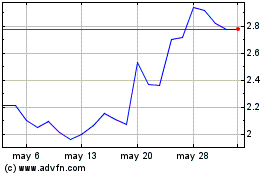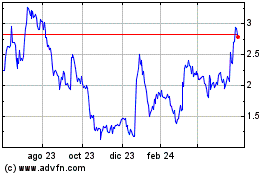HeartBeam Announces Positive Data from Two Studies at Prestigious American Heart Association Conference
19 Noviembre 2024 - 7:31AM
Business Wire
- The studies further strengthen HeartBeam’s body of clinical
evidence for its portable, cable-free, credit card-sized device
that is designed to be capable of synthesizing a 12-lead ECG
- The first study is a pilot study demonstrating similar
performance of HeartBeam’s vector-based ambulatory technology to
standard 12-lead ECGs for arrhythmia detection
- The second study is a feasibility study highlighting the
potential of HeartBeam’s technology with a novel risk-score
assessment algorithm to evaluate chest pain remotely and reduce
delays in care for patients experiencing a heart attack
HeartBeam, Inc. (NASDAQ: BEAT), a medical technology
company focused on transforming cardiac care by providing powerful
cardiac insights wherever the patient is, announced the results
from two studies evaluating HeartBeam’s groundbreaking vector-based
technology. The data add to the body of clinical evidence for the
Company’s key clinical indications, specifically arrhythmia and
heart attack (myocardial infarction) detection, and showcase the
technology’s pivotal role in advancing patient care for these
clinical indications. The studies were presented during the
American Heart Association’s annual Scientific Sessions in Chicago,
November 16-18, 2024.
HeartBeam’s vector-based technology captures the heart’s
electrical signals from three dimensions. The Company’s first
application of its groundbreaking technology is a cable-free,
credit card-sized device that is designed to be capable of
synthesizing a 12-lead electrocardiogram (ECG). The small size
makes it convenient for patients to always have the device with
them, ready to record an ECG whenever they feel symptoms to
minimize delays in care. The HeartBeam system is currently under
review with the FDA.
“The data presentations at AHA are a testament to HeartBeam’s
dedication to building a robust body of clinical evidence to
support our groundbreaking technology as we strive to make it
easier for patients and physicians to monitor cardiac symptoms and
seek timely diagnosis outside of a healthcare facility,” said
Robert Eno, Chief Executive Officer, HeartBeam. “We thank our
physician collaborators for their commitment to evaluating the
value our technology can bring in different clinical situations and
transform how cardiac conditions are managed in the future.”
The first presentation by Thomas Deering, MD, FACC, FHRS, Chief
of Arrhythmia Center, Piedmont Healthcare in Atlanta, GA,
highlighted results from an 80-patient pilot study, which evaluated
the performance of HeartBeam’s synthesized 12-lead ECG waveforms
compared to simultaneously collected standard 12-lead ECGs for
arrhythmia detection. The study found excellent agreement when
physicians diagnosed various arrhythmias utilizing the HeartBeam
synthesized 12-lead ECG compared to a standard 12-lead ECG
(Sensitivity: 94%, Specificity: 100%). Arrhythmias evaluated
include sinus rhythm, atrial fibrillation, atrial flutter, and
sinus with premature ventricular contraction (PVC) or premature
atrial contraction (PAC). This study is a precursor to the
Company’s pivotal study, VALID-ECG, which completed enrollment in
June. VALID-ECG will support the clinical equivalence basis for the
synthesized 12-lead ECG software in the Company’s next FDA
submission.
“One of the main challenges with timely assessment of
arrhythmias is that a single-lead ECG does not contain complete
diagnostic information, and at the same time, obtaining a standard
12-lead ECG is highly impractical outside of a medical setting,”
commented Dr. Deering. “Our study showed that the synthesized
12-lead ECG obtained from the HeartBeam device is similar to a
12-lead ECG, allowing patients to easily obtain the highest
fidelity ECG data wherever they are upon symptom onset and greatly
reduce any potential delays in receiving care.”
A second study presented by Alexei Shvilkin, MD, PhD, Clinical
Cardiac Electrophysiologist, Beth Israel Deaconess Medical Center
in Boston, MA, evaluated the feasibility of calculating an acute
coronary syndrome (ACS) risk score for assessment of chest pain
using the Company’s proprietary algorithm. This algorithm has the
potential to shorten the time between when heart attack symptoms
begin and when patients arrive at a medical facility, which is
essential for improving outcomes. The study found HeartBeam’s
algorithm accurately detected ACS and matched the assessment of
expert Emergency Department physicians who typically rely on
standard 12-lead ECGs for ACS assessment. This data builds on the
previously published JACC: Advances study, which demonstrated that
HeartBeam’s technology is comparable to 12-lead ECGs in identifying
coronary occlusions. The latest findings reinforce the potential of
the Company’s technology to facilitate evaluation of patient’s
chest pain symptoms outside of a medical facility to reduce delays
in care.
About HeartBeam, Inc.
HeartBeam, Inc. (NASDAQ: BEAT) is a medical technology company
dedicated to transforming cardiac care by providing powerful
cardiac insights wherever the patient is. The Company is creating
the first ever cable-free 12-lead ECG capable of capturing the
heart’s electrical signals from three dimensions. This platform
technology is designed to be used in portable devices that can be
used wherever the patient is to deliver actionable heart
intelligence. Physicians will be able to identify cardiac health
trends and acute conditions and direct patients to the appropriate
care – all outside of a medical facility, thus redefining the
future of cardiac health management. The Company holds 13 US and 4
international issued patents related to technology enablement.
For additional information, visit HeartBeam.com.
Forward-Looking Statements
All statements in this release that are not based on historical
fact are "forward-looking statements." While management has based
any forward-looking statements included in this release on its
current expectations, the information on which such expectations
were based may change. Forward-looking statements involve inherent
risks and uncertainties which could cause actual results to differ
materially from those in the forward-looking statements, as a
result of various factors including those risks and uncertainties
described in the Risk Factors and in Management’s Discussion and
Analysis of Financial Condition and Results of Operations sections
of our Forms 10-K, 10-Q and other reports filed with the SEC and
available at www.sec.gov. We urge you to consider those risks and
uncertainties in evaluating our forward-looking statements. We
caution readers not to place undue reliance upon any such
forward-looking statements, which speak only as of the date made.
Except as otherwise required by the federal securities laws, we
disclaim any obligation or undertaking to publicly release any
updates or revisions to any forward-looking statement contained
herein (or elsewhere) to reflect any change in our expectations
with regard thereto or any change in events, conditions or
circumstances on which any such statement is based.
View source
version on businesswire.com: https://www.businesswire.com/news/home/20241119868131/en/
Investor Relations Contact: Chris Tyson Executive Vice
President MZ North America Direct: 949-491-8235 BEAT@mzgroup.us
www.mzgroup.us Media Contact:media@heartbeam.com
HeartBeam (NASDAQ:BEAT)
Gráfica de Acción Histórica
De Dic 2024 a Ene 2025

HeartBeam (NASDAQ:BEAT)
Gráfica de Acción Histórica
De Ene 2024 a Ene 2025
